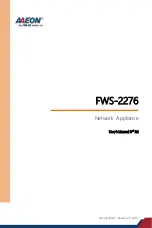
Default: 30
WebUI HTTP port
Specifies the HTTP port for the Web Interface.
Default: 80
WebUI HTTPS port
Specifies the HTTP(S) port for the Web Interface.
Default: 443
HTTPS Certificate
Specifies which certificate to use for HTTPS traffic. Only RSA certificates are supported.
Default: HTTPS
2.1.9. Working with Configurations
Configuration Objects
The system configuration is built up by Configuration Objects, where each object represents a
configurable item of any kind. Examples of configuration objects are routing table entries, address
book entries, service definitions, IP rules and so on. Each configuration object has a number of
properties that constitute the values of the object.
Object Types
A configuration object has a well-defined type. The type defines the properties that are available for
the configuration object, as well as the constraints for those properties. For instance, the IP4Address
type is used for all configuration objects representing a named IPv4 address.
Object Organization
In the Web Interface the configuration objects are organized into a tree-like structure based on the
type of the object.
In the CLI, similar configuration object types are grouped together in a category. These categories
are different from the structure used in the Web Interface to allow quick access to the configuration
objects in the CLI. The IP4Address, IP4Group and EthernetAddress types are, for instance, grouped
in a category named Address, as they all represent different addresses. Consequently, Ethernet and
VLAN objects are all grouped in a category named Interface, as they are all interface objects. The
categories have actually no impact on the system configuration; they are merely provided as means
to simplify administration.
The following examples show how to manipulate objects.
Example 2.3. Listing Configuration Objects
To find out what configuration objects exist, you can retrieve a listing of the objects. This example shows how to
list all service objects.
2.1.9. Working with Configurations
Chapter 2. Management and Maintenance
51
Summary of Contents for NetDefend DFL-260E
Page 27: ...1 3 NetDefendOS State Engine Packet Flow Chapter 1 NetDefendOS Overview 27...
Page 79: ...2 7 3 Restore to Factory Defaults Chapter 2 Management and Maintenance 79...
Page 146: ...3 9 DNS Chapter 3 Fundamentals 146...
Page 227: ...4 7 5 Advanced Settings for Transparent Mode Chapter 4 Routing 227...
Page 241: ...5 4 IP Pools Chapter 5 DHCP Services 241...
Page 339: ...6 7 Blacklisting Hosts and Networks Chapter 6 Security Mechanisms 339...
Page 360: ...7 4 7 SAT and FwdFast Rules Chapter 7 Address Translation 360...
Page 382: ...8 3 Customizing HTML Pages Chapter 8 User Authentication 382...
Page 386: ...The TLS ALG 9 1 5 The TLS Alternative for VPN Chapter 9 VPN 386...
Page 439: ...Figure 9 3 PPTP Client Usage 9 5 4 PPTP L2TP Clients Chapter 9 VPN 439...
Page 450: ...9 7 6 Specific Symptoms Chapter 9 VPN 450...
Page 488: ...10 4 6 Setting Up SLB_SAT Rules Chapter 10 Traffic Management 488...
Page 503: ...11 6 HA Advanced Settings Chapter 11 High Availability 503...
Page 510: ...12 3 5 Limitations Chapter 12 ZoneDefense 510...
Page 533: ...13 9 Miscellaneous Settings Chapter 13 Advanced Settings 533...









































